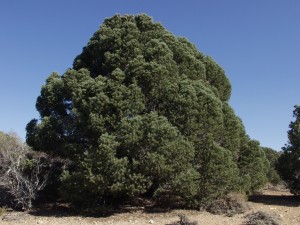Creepy Crawlies and Pinyon Pine
February 12th, 2014
One of my favorite things about living in the Wildland-Urban Interface (WUI) is that I can walk out my front door and start hiking within moments of leaving my house.
I love to study pinyon pine trees on my hikes. They have needles and drop pine cones like a pine tree should, but they make the most interesting shapes. Instead of the conical, straight-up-and-down shape you’d expect from an iconic pine tree, their branches twist and extend out wide at all angles, almost like an oak tree. They’re so much fun to look at because they’re all so individual!
Imagine my delight when I found a publication called “Pinyon Pine Management Guidelines For Common Pests” on the Living With Fire website. The booklet is short – an easy Sunday afternoon read – and tells all about how to manage pinyon pine on your property as well as their general forest management guidelines. When properly cared for, they can survive disease and resist beetle attack. Wait… what?
Beetle attack. The paper devotes a large section to common pests that would infect pinyon pine. At the top of the list is the Pinyon Ips beetle. These nasty little buggers, dark brown or black bugs that are approximately 1/4 inch long, attack the tree and leave it in terrible shape after they’re done. The process goes like this: a male bores into the bark of the tree and releases a pheromone to call other male and female beetles; they mate and the females engrave canals to lay eggs; the eggs hatch and little white larvae eat the inner bark; finally, once they all grow up, they fly on to other trees and the process starts over. Is your skin crawling yet? Mine is.
Pinyon Ips beetles target drought-stressed trees or trees that have fresh wounds for entry; because of this, the booklet suggests that pinyon pines should only be pruned during fall and winter months. Trees that have been attacked will have boring dust in the bark crevices and at the base of the tree, as well as gobs of pitch on the outer-bark. Between a fungus carried by the beetle and their meal-time habits, Ips beetles can be fatal to pinyon pine, and dead trees are like roman candles in the WUI. All it would take is one traveling ember from a wildfire and it will ignite, endangering everything around it.
The pinyon pine is Nevada’s state tree and is one of the many treasures of our landscape. For information on pinyon pine, read “Pinyon Pine Management Guidelines For Common Pests.” To learn how to make your home and community safer from the threat of wildfire, visit www.livingwithfire.info.
Hope to see you hiking among the pinyon pine!
Natalie Newcomer
